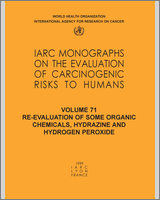NCBI Bookshelf. A service of the National Library of Medicine, National Institutes of Health.
IARC Working Group on the Evaluation of Carcinogenic Risks to Humans. Re-evaluation of Some Organic Chemicals, Hydrazine and Hydrogen Peroxide. Lyon (FR): International Agency for Research on Cancer; 1999. (IARC Monographs on the Evaluation of Carcinogenic Risks to Humans, No. 71.)
Data were last reviewed in IARC (1985) and the compound was classified in IARC Monographs Supplement 7 (1987).
1. Exposure Data
1.1. Chemical and physical data
1.1.1. Nomenclature
- Chem. Abstr. Serv. Reg. No.: 101-90-6
- Chem. Abstr. Name: Oxirane, 2,2′-[phenylenebis(oxymethylene)]bis-
1.1.2. Structural and molecular formulae and relative molecular mass

1.1.3. Physical properties (for details, see IARC, 1985)
- Boiling point: 172°C at 106 Pa
- Conversion factor: mg/m3 = 9.09 × ppm
1.2. Production and use
Diglycidyl resorcinol ether has been produced since at least 1974. It has only limited application, principally in the aerospace industry (IARC, 1985).
2. Studies of Cancer in Humans
No data were available to the Working Group.
3. Studies of Cancer in Experimental Animals
Diglycidyl resorcinol ether (technical grade) was tested for carcinogenicity by gavage in mice of one strain and in rats of one strain. It induced squamous-cell carcinomas and papillomas of the forestomach in animals of both species. In female mice, an increased incidence of hepatocellular tumours was observed. In one experiment in mice, no skin tumour was observed after skin application (IARC, 1985).
4. Other Data Relevant to an Evaluation of Carcinogenicity and its Mechanisms
4.1. Absorption, distribution, metabolism and excretion
No data were available to the Working Group.
4.2. Toxic effects
4.2.1. Humans
Diglycidyl resorcinol ether causes burns and skin sensitization (IARC, 1985).
4.2.2. Experimental systems
Application of diglycidyl resorcinol ether caused irritation to the eyes and skin of rabbits. Once-monthly intravenous injection of the compound at doses of 100–200 mg/kg bw produced a progressive lowering of the leukocyte count in monkeys. Hyperkeratosis and basal-cell hyperplasia in the forestomach were observed in rats and mice exposed daily to intragastric doses of 12.5 mg/kg bw and higher for 13 weeks. In a two-year study in rats, dose-related bronchopneumonia occurred, which was not consistent with chemical pneumonitis, but was characterized by polymorphonuclear leukocytes in the alveoli. The compound also inhibited the growth of Walker carcinoma in rats (IARC, 1985). The occurrence of forestomach hyperkeratosis and epithelial cell proliferation was confirmed in a two-week study in rats with doses of 25 mg/kg bw, but not with 12 mg/kg bw (Ghanayem et al., 1986).
4.3. Reproductive and developmental effects
No data were available to the Working Group.
4.4. Genetic and related effects
4.4.1. Humans
No data were available to the Working Group.
4.4.2. Experimental systems (see Table 1 for references)
Table 1
Genetic and related effects of diglycidyl resorcinol ether (technical grade).
Diglycidyl resorcinol ether (technical grade) was mutagenic to Salmonella typhimurium and at the tk locus but not the hprt locus of cultured mouse lymphoma cells. It induced chromosomal aberrations in Chinese hamster ovary CHO cells, but did not increase the proportion of micronucleated cells in the bone marrow of treated mice.
5. Evaluation
No epidemiological data relevant to the carcinogenicity of diglycidyl resorcinol ether were available.
There is sufficient evidence for the carcinogenicity of a technical grade of diglycidyl resorcinol ether in experimental animals.
Overall evaluation
Diglycidyl resorcinol ether (technical grade) is possibly carcinogenic to humans (Group 2B).
6. References
- Ghanayem B.I., Maronpot R.R., Matthews H.B. Association of chemically induced forestomach cell proliferation and carcinogenesis. Cancer Lett. 1986;32:271–278. [PubMed: 3768853]
- IARC (1985) IARC Monographs on the Evaluation of the Carcinogenic Risk of Chemicals to Humans, Volume 36, Allyl Compounds, Aldehydes, Epoxides and Peroxides, Lyon, pp. 181–188. [PubMed: 3864732]
- IARC (1987) IARC Monographs on the Evaluation of Carcinogenic Risks to Humans, Supplement 7, Overall Evaluations of Carcinogenicity: An Updating of IARC Monographs Volumes 1 to 42, Lyon, p. 62. [PubMed: 3482203]
- McGregor D.B., Brown A., Cattanach P., Edwards I., McBride D., Riach C., Caspary W.J. Responses of the L5178Y tk+/tk− mouse lymphoma cell forward mutation assay: III. 72 coded chemicals. Environ. mol. Mutag. 1988;12:85–154. [PubMed: 3383842]
- McGregor D.B., Riach C., Cattanach P., Edwards I., Shepherd W., Caspary W.J. Mutagenic responses of L5178Y mouse lymphoma cells at the tk and hprt loci. Toxicol. In Vitro. 1996;10:643–647. [PubMed: 20650247]
- Seiler J.P. The mutagenicity of mono- and difunctional aromatic glycidyl compounds. Mutat. Res. 1984;135:159–167. [PubMed: 6369127]
- United States National Toxicology Program (1986) NTP Technical Report on the Toxicology and Carcinogenesis Studies of Diglycidyl Resorcinol Ether (Technical Grade) (CAS No. 101-90-6) in F344/N Rats and B6C3F1 Mice (Gavage Study) (NIH Publ. No. 87-2513; NTP TR 257), Research Triangle Park, NC, United States Department of Health and Human Services. [PubMed: 12748690]
- PubMedLinks to PubMed
- Diglydicyl resorcinol ether - Re-evaluation of Some Organic Chemicals, Hydrazine...Diglydicyl resorcinol ether - Re-evaluation of Some Organic Chemicals, Hydrazine and Hydrogen Peroxide
- Dimethylcarbamoyl chloride - Re-evaluation of Some Organic Chemicals, Hydrazine ...Dimethylcarbamoyl chloride - Re-evaluation of Some Organic Chemicals, Hydrazine and Hydrogen Peroxide
Your browsing activity is empty.
Activity recording is turned off.
See more...
